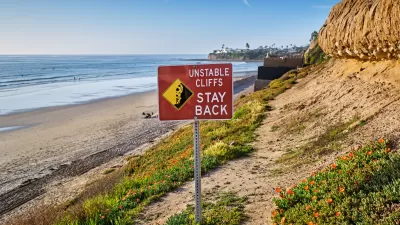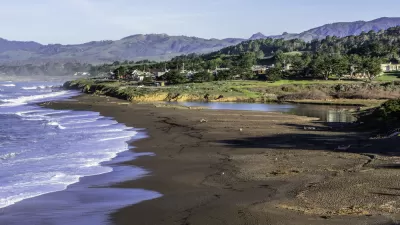California is working on a plan to adapt infrastructure statewide to the future impacts of climate change.

Amid a number of new policies in California putting climate adaptation at the front and center, the state is also pursuing an update of the Safeguarding California Action Plan—a comprehensive collection of strategies to mitigate the risks that climate impacts like sea-level rise, drought, flooding, and tree die-off pose to California’s water supply, energy grid, agriculture, and urban infrastructure.
The chair of the state Natural Resources Agency, John Laird, spoke to The Planning Report to delve deeper into this complex assortment of variables.
Among the strategies the agency is exploring is the creation of a regional energy grid, which could help stabilize the supply of renewable energy by allowing Western states to share the resources local to them.
Laird also supports the governor’s contentious plan to build a tunnel system in the Bay Delta. For him, resilience is the lynchpin that can unite the area's embroiled interests under one plan.
I sometimes say that dealing with the issues in the Delta is bit like dealing with peace in the Middle East: People have their basic beliefs, and they don’t cross over. But the issue of resiliency could provide a way to talk about it that everyone can understand.
Some of Laird's expertise is tied to his own brushes with disaster. In 2011, he was chairing a meeting of the state’s Ocean Protection Council when the Tōhoku tsunami hit the California coast. And in 1989, he was a city councilmember when the Loma Prieta earthquake destroyed Downtown Santa Cruz.
That hard-won experience has convinced him that the public can, and must, understand how a complex global process like climate change can quickly become close to home.
"There are variables to this," he says. "I think it’s important to develop the science, bring it home to the public, and use examples that people have experienced—like the tsunami—to make sure that people understand the urgency."
FULL STORY: Safeguarding California: CA’s Natural Resources Secretary on Resiliency & Climate Change Plans

Maui's Vacation Rental Debate Turns Ugly
Verbal attacks, misinformation campaigns and fistfights plague a high-stakes debate to convert thousands of vacation rentals into long-term housing.

Planetizen Federal Action Tracker
A weekly monitor of how Trump’s orders and actions are impacting planners and planning in America.

In Urban Planning, AI Prompting Could be the New Design Thinking
Creativity has long been key to great urban design. What if we see AI as our new creative partner?

King County Supportive Housing Program Offers Hope for Unhoused Residents
The county is taking a ‘Housing First’ approach that prioritizes getting people into housing, then offering wraparound supportive services.

Researchers Use AI to Get Clearer Picture of US Housing
Analysts are using artificial intelligence to supercharge their research by allowing them to comb through data faster. Though these AI tools can be error prone, they save time and housing researchers are optimistic about the future.

Making Shared Micromobility More Inclusive
Cities and shared mobility system operators can do more to include people with disabilities in planning and operations, per a new report.
Urban Design for Planners 1: Software Tools
This six-course series explores essential urban design concepts using open source software and equips planners with the tools they need to participate fully in the urban design process.
Planning for Universal Design
Learn the tools for implementing Universal Design in planning regulations.
planning NEXT
Appalachian Highlands Housing Partners
Mpact (founded as Rail~Volution)
City of Camden Redevelopment Agency
City of Astoria
City of Portland
City of Laramie





























